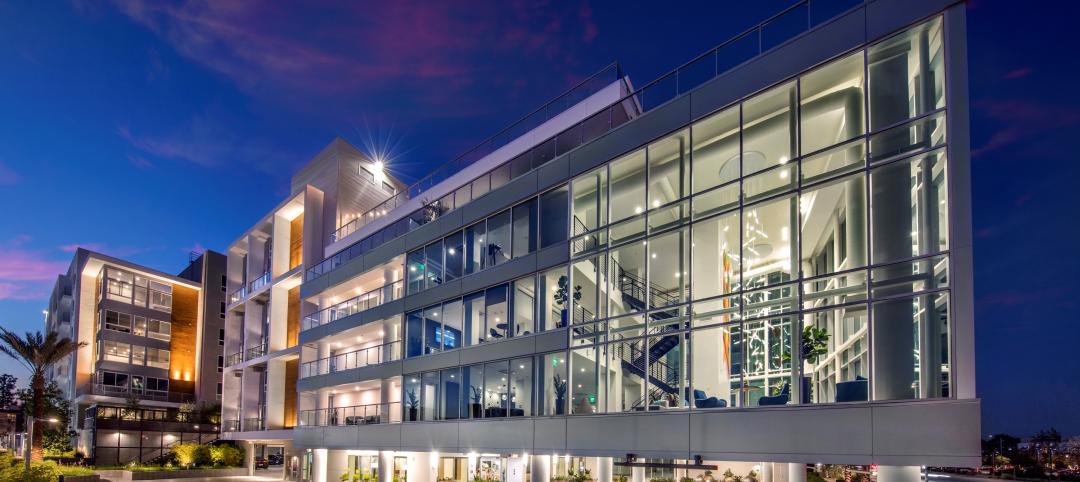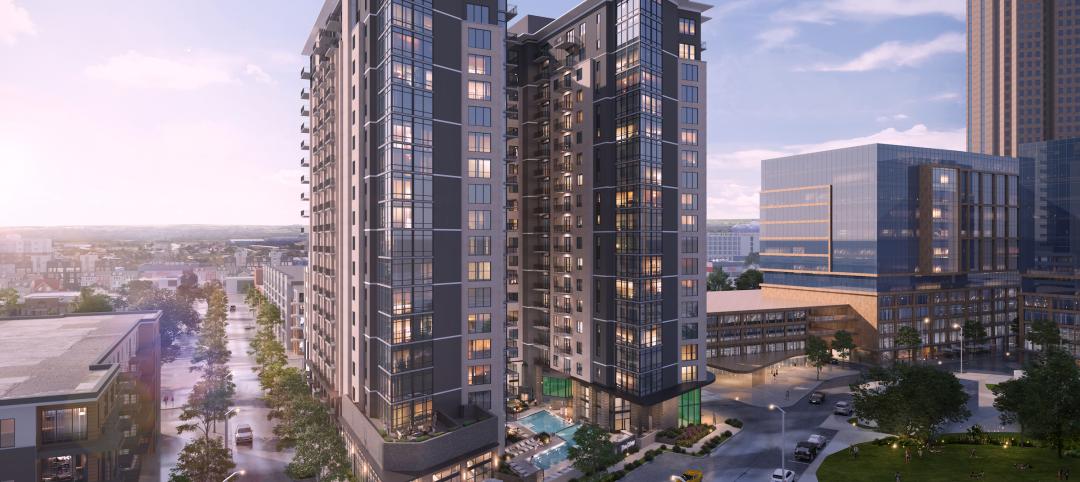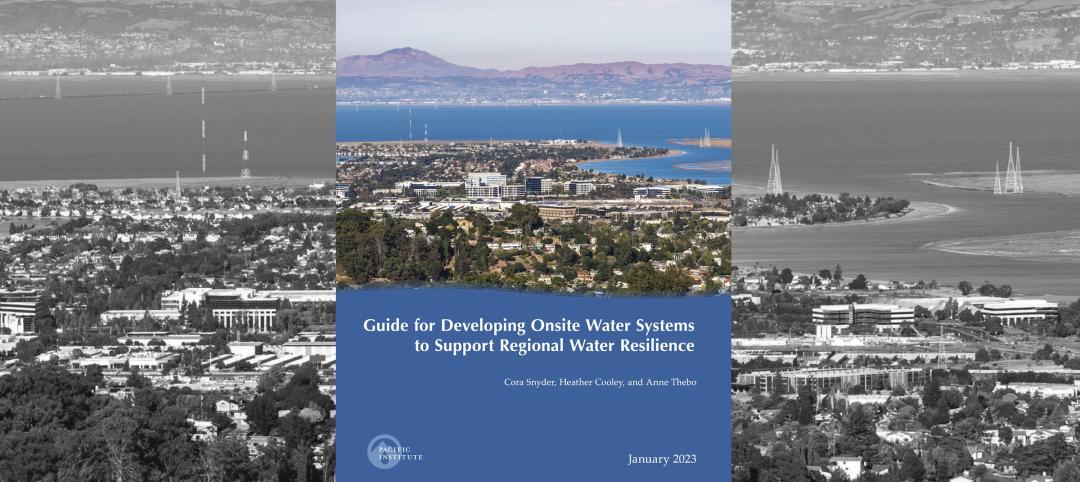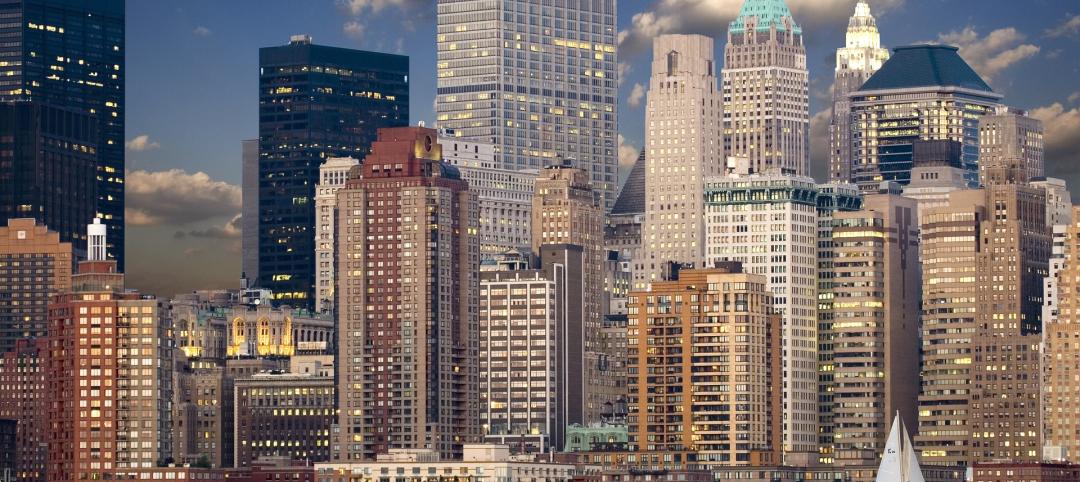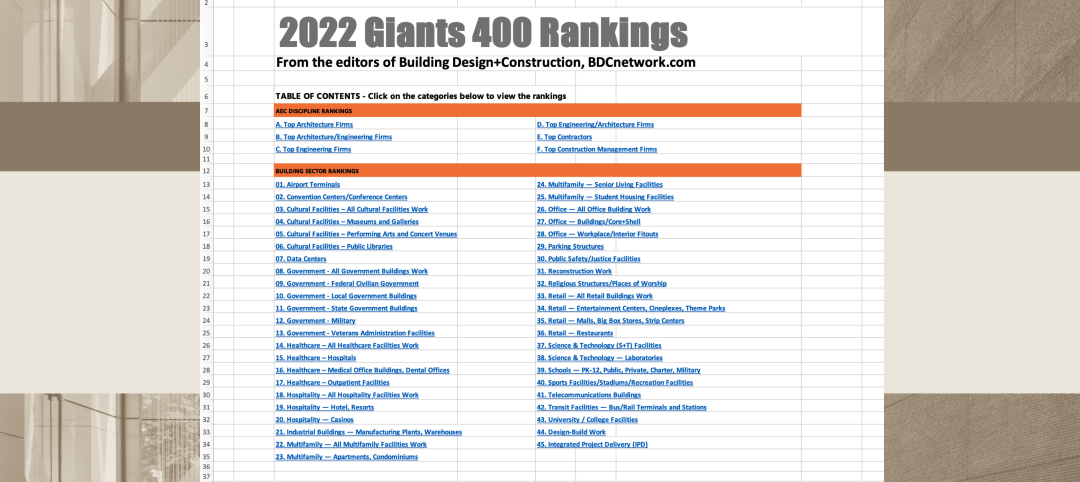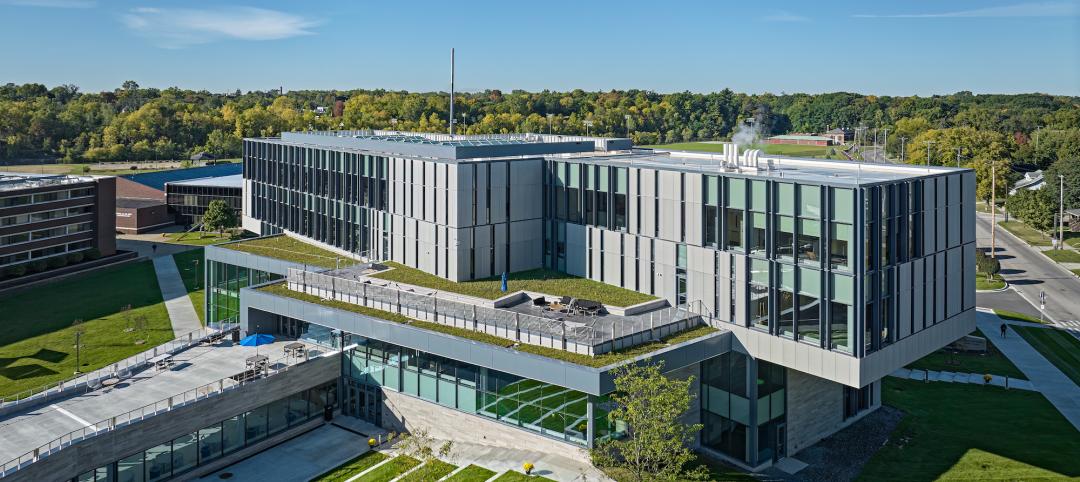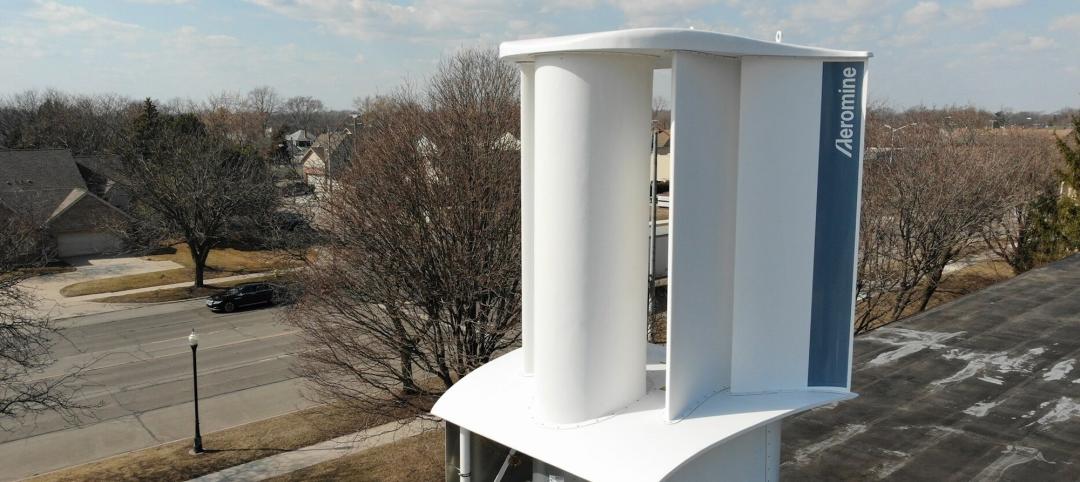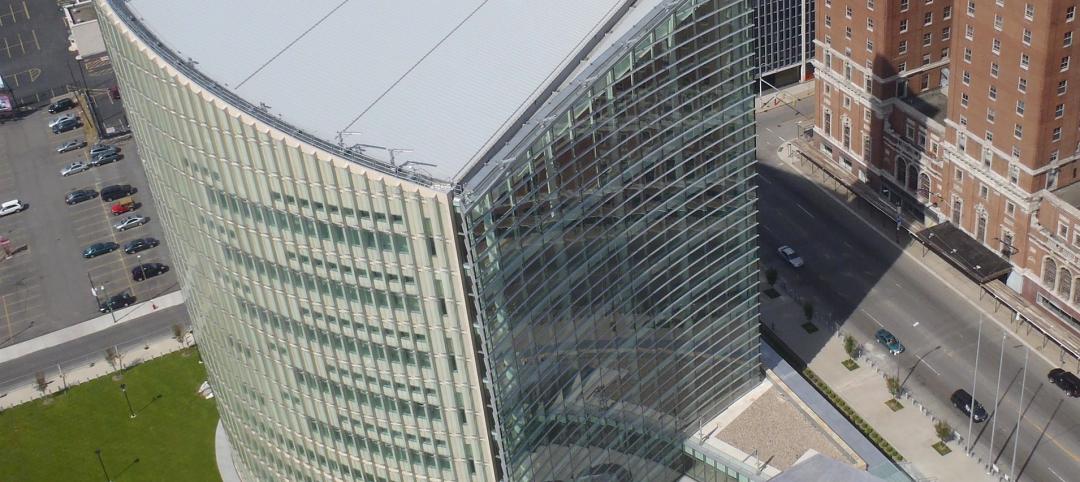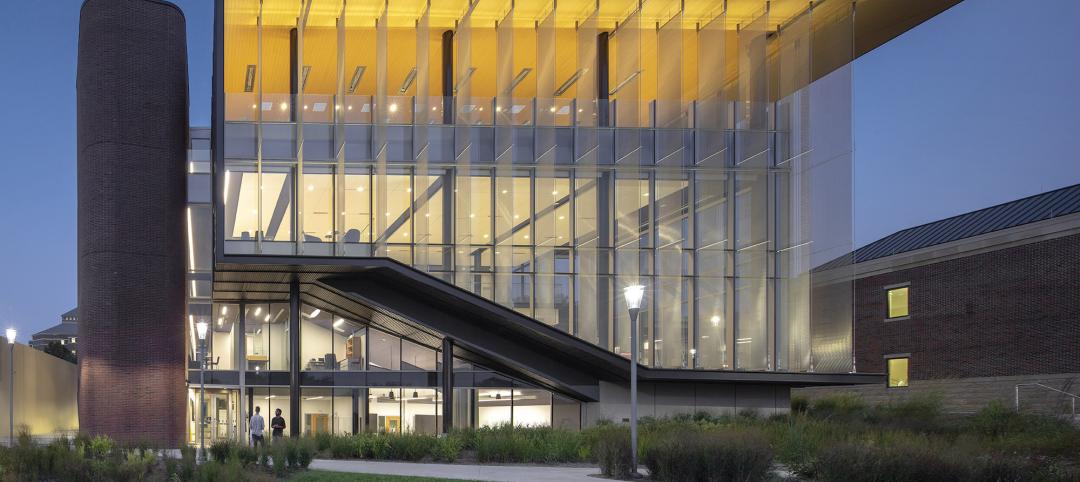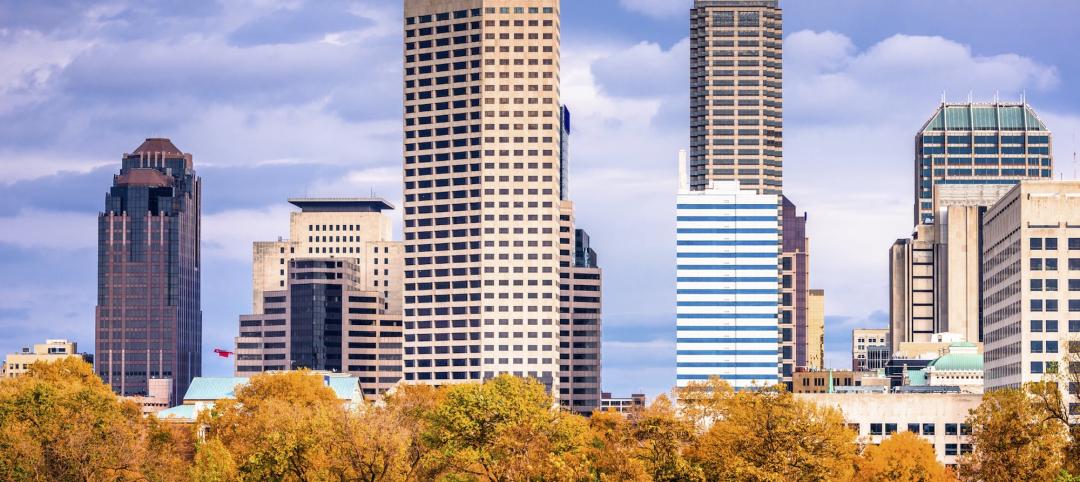By the mid 21st century, over three quarters of the world’s population could be living in urban areas. Relentless urbanization must reckon with the reality of climate change, which compels AEC firms and their clients to rethink the built environment with an eye toward resilience and preservation.
“The greatest potential impact comes from design itself,” states Gensler in its third annual “Impact by Design” report. Gensler asserts that while the business case for sustainable design “has never been clearer,” the specifics for achieving higher levels of sustainability “are changing.”
The report revolves around six topics—form, materials, adaptation, energy, water, and intelligence—where Gensler believes design can have the greatest positive impact in the coming years. “Our goals are to expand the discussion of resilience beyond just energy efficiency, and [to] demystify complex conceptualizations to encourage broader adoption of resilient methods.”
Gensler stakes its claim for authority in these matters by noting that its estimated 1.25 million sf of project work in 2017 were designed to keep nearly 11 million metric tons of C02 from entering the atmosphere on an annual basis.
The firm’s analysis of its 2017 portfolio found that its more than 800 million sf of work have an averaged predicted Energy Unit Intensity (pEUI) of 42.5 Kilo British Thermal Units (KBTU) per sf per year, a 59% improvement over the firm’s calculated equivalent in 2003. Its more than 400 million sf of interiors work have an averaged predicted Lighting Power Density (LPD) of 0.81 watts per sf, a 29% improvement over the firm’s calculated ASHRAE 90.1 2007 equivalent.
FORM: To achieve effective resilience, cities must experiment with new forms that reassess location, proportion, orientation, fenestration, and “augmentation” (i.e., additions that maximize a building’s performance). “Early intervention is crucial,” says the report.
Gensler’s design proposal for the 1.2 million sf Zhuhai Huace Plaza, in Guangdong, China, merges two towers into a single structure that focuses on sustainable performance, community connectivity, and the integration of nature. A vertical atrium system embeds vegetation at all levels of the building, while creating a breathing envelope that brings draft winds into the building. Performance is further optimized via intelligent building controls.
The firm’s design for the 430,000-sf Harbin Bank headquarters in Beijing includes a double-glazed high-performance façade to reduce the building’s cooling load by over 50% in the summer and minimize heating loads by up to 40% in the winter. That system is coupled with automatic blinds to facilitate occupant access to daylight whenever possible, while providing sufficient solar shading and mitigating glare. The building requires 11% less mechanical equipment.
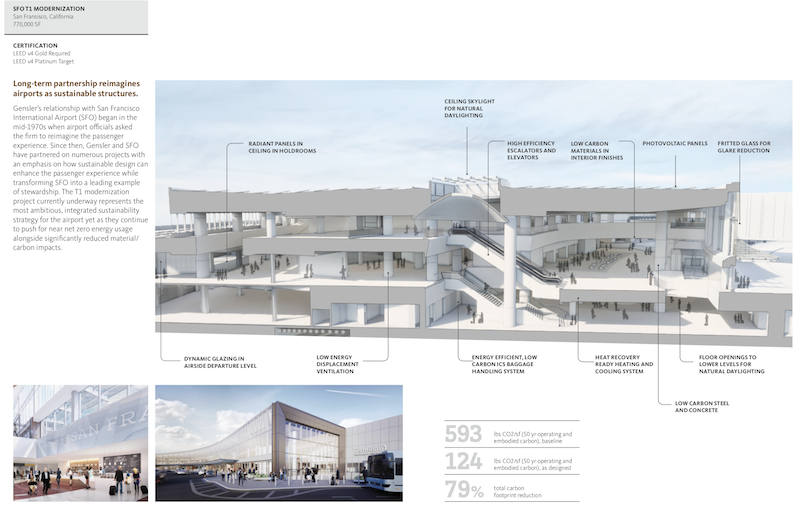 The choice of materials is a major component in the modernization of San Francisco International airport's Terminal 1, which when completed is expected to reduce its carbon emissions by 79%, compared to its previous baseline, over 50 years. Image: Gensler
The choice of materials is a major component in the modernization of San Francisco International airport's Terminal 1, which when completed is expected to reduce its carbon emissions by 79%, compared to its previous baseline, over 50 years. Image: Gensler
MATERIALS: Sustainability usually starts with materials selection. “We must prioritize lifecycle thinking for every design we create and every material, furniture, and fixture we specify,” Gensler states, adding that “minimizing embodied carbon has become a point of emphasis within our portfolio.”
A prime example can be found in Gensler’s design for the ongoing modernization of San Francisco International Airport’s 86,000-sf Terminal 1, which Gensler claims “represents the most ambitious, integrated sustainability strategy for the airport yet, as they continue to push for near net zero energy usage alongside significantly reduced material/carbon impacts.”
The building products chosen for that terminal include dynamic glazing and radiant ceiling panels in hold rooms, low-carbon steel, concrete, and interior finishes; installations of a ceiling skylight and floor openings to lower levels for natural daylighting; high-efficiency escalators and elevators; solar panels; fritted glass for glare reduction; and low-energy displacement ventilation.
The modernization, upon completion, is expected to earn LEED Gold certification.
ADAPTATION: Gensler’s report laments that, globally, there’s still too many poorly performing buildings, and the current retrofit rate is sluggish: in the U.S., only 2.2 billion sf, or 2% of total floor space, gets refurbished each year. So there’s plenty of opportunity to renovate buildings in ways the produce environmental, economic, and social benefits.
Gensler acknowledges the barriers to energy refurbishment of buildings: renovation cost, access to finance, rapid ROI, low energy prices, lack of technical solutions, lack of skilled labor, supply-chain fragmentation, and lack of awareness. But its report insists that the AEC industry must develop strategies to improve an existing building’s performance without needing to tear it down.
Take, for example, the adaptive reuse of the former Balcones Resources recycling warehouse in East Austin, Texas, for UpCycle, an 81,000-sf institutional-quality office building. Gensler’s design reuses 95 percent of the existing warehouse’s structure, even the building skin, which is turned inside out to reveal its natural finish. Even old elements such as exhaust fans were reused as decorative design features.
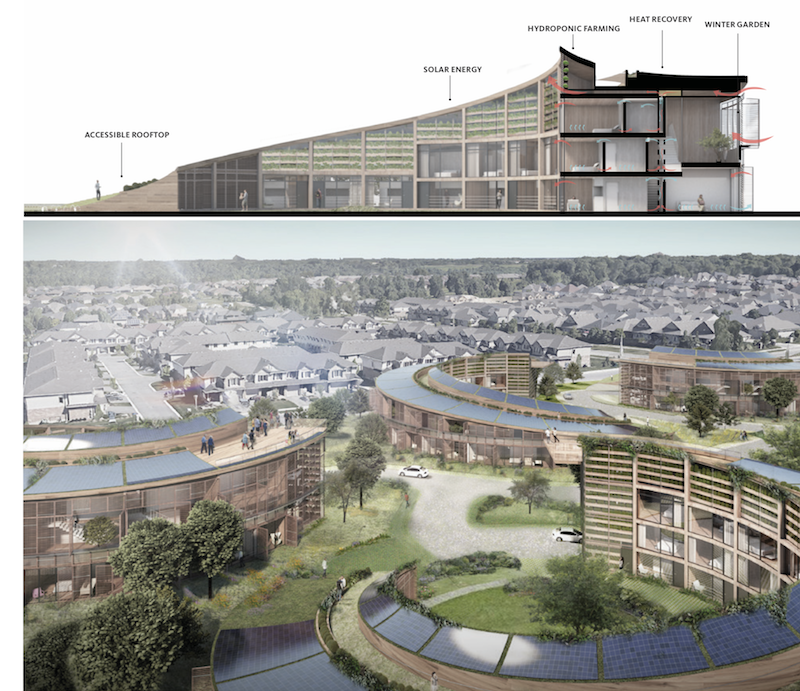
Gensler's master plan and concept design for a net-zero energy 52-townhouse neighborhood incorporates an autonomous vehicle network on the premises with solar panels and a rooftop hydroponic farm. Image: Gensler
ENERGY: The ultimate goal for new construction and renovation is to reduce the energy impact of buildings to zero, either by reducing consumption, creating new energy, or buying energy.
Gensler observes that conversations about energy reduction more frequently veer toward procurement of renewables, which becomes increasingly viable as energy grids in more markets accommodate and offer more renewable options.
The report points specifically to the 8,000-sf Sustainability Center at the University of California-Northridge, the first ZNE building in the state’s university system. It includes a 25-kW rooftop PV array coupled with a glazed overhead window, which eliminates the need for artificial light. All of the building’s hot water needs are met by solar thermal and hybrid hot water heat pumps. The installation of vacuum composting toilets reduces annual water use by 43,500 gallons. The building’s cladding is a cementitious panel system that’s repurposed from cement panels. Grey water is used for irrigation.
Gensler has also come up with a design concept for an Electric Vehicle Enclave that would be part of a new suburban housing model that supports community building through common courtyards, and assumes the ubiquity of automated vehicles in the future. This concept includes a year-round hydroponic farm.
WATER: The report includes a map that shows the cities and regions globally that are most vulnerable to coastal flooding. Possible solutions to mitigate that risk include canals that channel water away from the built environment to flood-proofed sites, and coastal dunes and dedicated wetlands that inhibit flooding and appropriately store both flood and fresh water. “The design of individual buildings must then be considered.”
Gensler’s ambitious Miami Waterway concept proposal explores how zoning codes and development policies could require existing communities at higher elevation points to acquire increased levels of residential and commercial density, thus creating heavily populated, commercially stable areas that are insulated from flooding.
Lower-lying areas would be zoned as parks and wetlands, effectively acting as buffer zones that protect the surrounding areas from water fluctuations. A man-made delta capable of integrating higher water levels into the urban fabric without threatening residents or businesses—including the transformation of streets into canals—would result in a transportation network that can serve the needs of a denser city while reducing individual vehicle usage.
INTELLIGENCE:
This solution foresees the broader application of sensor and network technologies. The next iteration of smart buildings will leverage advances in sensor technology alongside an increased number of IoT-enabled devices. The optimization of operations would include efficiency, responsiveness, and anticipation. Intelligent design would allow building occupants to have a more direct relationship to their building.
Johnson Controls’ 376,000-sf Asia-Pacific headquarters in Shanghai, which has earned both LEED Platinum and EDGE certifications, operates with assistance from myriad advanced technologies, including a Metasys Building Automation System, a Central Plant, and LED lighting with daylight dimming, occupancy sensors, and interior façade roller shade system. The building is also equipped with 21,528 sf of solar panels.
The headquarters, which opened in June 2017, is expected to generate 44% savings in overall energy consumption compared to the local market standard, reduce water usage by 42% via its grey water recycling and rooftop storm water recapture facilities, and reduce embodied energy in materials by 21% through the use of Forest Stewardship Council-certified wood-based building materials and the sourcing of locally supplied products.
Related Stories
Multifamily Housing | Feb 11, 2023
8 Gold and Platinum multifamily projects from the NAHB's BALA Awards
This year's top BALA multifamily winners showcase leading design trends, judged by eight industry professionals from across the country.
Multifamily Housing | Feb 10, 2023
Dallas to get a 19-story, 351-unit residential high-rise
In Dallas, work has begun on a new multifamily high-rise called The Oliver. The 19-story, 351-unit apartment building will be located within The Central, a 27-acre mixed-use development near the Knox/Henderson neighborhood north of downtown Dallas.
Sustainability | Feb 9, 2023
New guide for planning, designing, and operating onsite water reuse systems
The Pacific Institute, a global nonpartisan water think tank, has released guidance for developers to plan, design, and operate onsite water reuse systems. The Guide for Developing Onsite Water Systems to Support Regional Water Resilience advances circular, localized approaches to managing water that reduce a site’s water footprint, improve its resilience to water shortage or other disruptions, and provide benefits for local communities and regional water systems.
Office Buildings | Feb 9, 2023
Post-Covid Manhattan office market rebound gaining momentum
Office workers in Manhattan continue to return to their workplaces in sufficient numbers for many of their employers to maintain or expand their footprint in the city, according to a survey of more than 140 major Manhattan office employers conducted in January by The Partnership for New York City.
Giants 400 | Feb 9, 2023
New Giants 400 download: Get the complete at-a-glance 2022 Giants 400 rankings in Excel
See how your architecture, engineering, or construction firm stacks up against the nation's AEC Giants. For more than 45 years, the editors of Building Design+Construction have surveyed the largest AEC firms in the U.S./Canada to create the annual Giants 400 report. This year, a record 519 firms participated in the Giants 400 report. The final report includes 137 rankings across 25 building sectors and specialty categories.
University Buildings | Feb 8, 2023
STEM-focused Kettering University opens Stantec-designed Learning Commons
In Flint, Mich., Kettering University opened its new $63 million Learning Commons, designed by Stantec. The new facility will support collaboration, ideation, and digital technology for the STEM-focused higher learning institution.
Sustainability | Feb 8, 2023
A wind energy system—without the blades—can be placed on commercial building rooftops
Aeromine Technologies’ bladeless system captures and amplifies a building’s airflow like airfoils on a race car.
Codes and Standards | Feb 8, 2023
GSA releases draft of federal low embodied carbon material standards
The General Services Administration recently released a document that outlines standards for low embodied carbon materials and products to be used on federal construction projects.
University Buildings | Feb 7, 2023
Kansas City University's Center for Medical Education Innovation can adapt to changes in medical curriculum
The Center for Medical Education Innovation (CMEI) at Kansas City University was designed to adapt to changes in medical curriculum and pedagogy. The project program supported the mission of training leaders in osteopathic medicine with a state-of-the-art facility that leverages active-learning and simulation-based training.
Multifamily Housing | Feb 7, 2023
Multifamily housing rents flat in January, developers remain optimistic
Multifamily rents were flat in January 2023 as a strong jobs report indicated that fears of a significant economic recession may be overblown. U.S. asking rents averaged $1,701, unchanged from the prior month, according to the latest Yardi Matrix National Multifamily Report.



